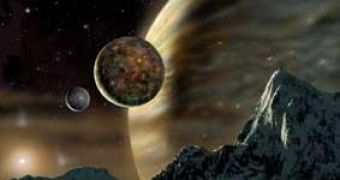In the attempt to find new solar systems and Earth-like planets, or possibly other signs of life in the universe, astronomers from the University of Texas have detected what appears to be the first planet outside the solar system to present an atmosphere.
The atmosphere surrounds an exoplanet that orbits the star known as HD189733, situated in the Vulpecula constellation about 63 light years away. It is a gas giant about 20 percent larger than Jupiter, which orbits ten times closer than the planet Mercury does around our Sun. Our Earth perspective of the distant solar system indicates that the planet passes directly in front of its star on every orbit, which also allowed its discovery in 2004.
Discovered by Francois Bouchy from the France Laboratoire d'Astrophysique de Marseille, it is the second extra-solar planet ever to be proven to have an atmosphere, after the detection made with Hubble's Space Telescope Imaging Spectrograph instrument, which broke down soon after its discovery and is currently inoperable, prompting the use of ground based observation instruments.
Attempts to discover similar exoplanets have been made ever since, with no conclusive results even though astronomers have mainly focused their attention on stars through single transit targets. So to obtain better results they shifted their work towards exoplanets with multiple transits. One year and 11 transits later using the HET and the High Resolution Spectrograph their were successful in obtaining the 'transit spectrum' of the planet, which could then be used to recreate a model of the chemical composition of its atmosphere.
The spectrum analysis of an exoplanet's atmosphere involves studying the light captured during the planet's transit in front of the star, then compare it with the spectrum of light obtained from the star when the planet is out of its way. Data extracted from the study revealed that the planet blocks about 2.5 percent of the light coming from the star when it passes in front of it, plus an extra 0.3 percent that accounts for the planet's atmosphere. Seth Redfield explains that, when a planet bearing no atmosphere passes in front of its star it would block the same amount of light every time in all the wavelengths. However if the planet does have an atmosphere, then it will absorb an extra amount of light.
Preliminary measurements predict that it has a sodium rich atmosphere.
The discovery of this planet came as a result of the study of hundreds of observations, made in different conditions spanning the time period of a year, including removing the parasite information that contaminated the data, as a result of emissions of our own atmosphere which usually show up in most measurements made with instruments on ground bases, to make sure that the detection is authentic.
According to Michael Endl, the HET instrument can also be used to examine the atmospheric properties of other exoplanets, not just discover them.

 14 DAY TRIAL //
14 DAY TRIAL //